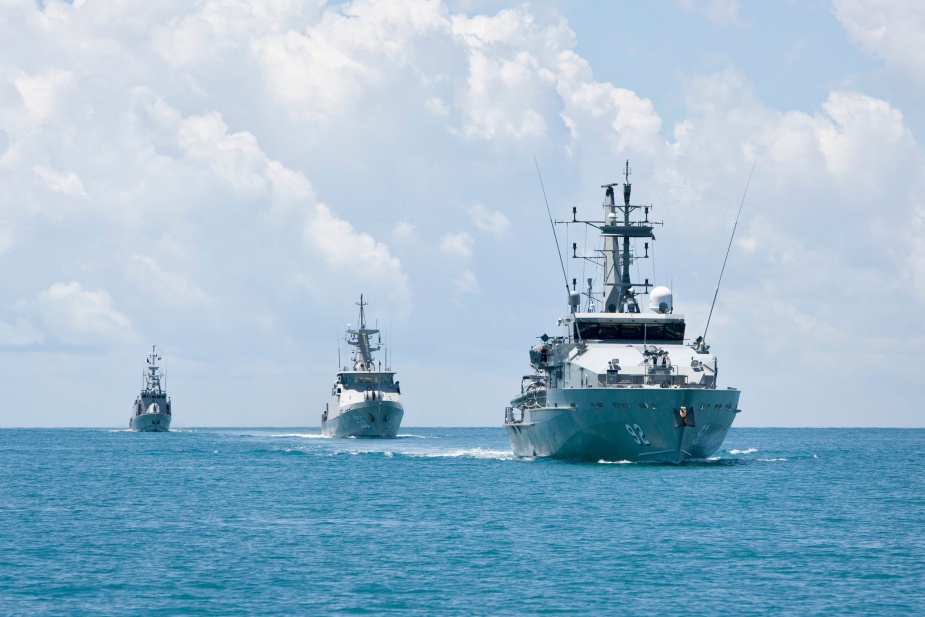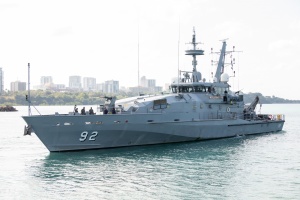
HMAS Wollongong in formation with Indonesian Naval vessels, KRI Samapri and KRI Layang, before entering Darwin Harbour on conclusion of Exercise CASSOWARY 2016.
Commissioning
HMAS Wollongong (III) was commissioned in a ceremony conducted at Garden Island Sydney on Saturday 23 June 2007 under the command of Lieutenant Commander M.W Taylor RAN. The Australian white ensign raised during the ceremony was previously flown in the boat’s namesake vessel, HMAS Wollongong (II).
Following the commissioning, Wollongong proceeded south to the boat’s namesake city for several days of functions, receptions and relationship building endeavours. These included a mayoral reception, the embarkation of students from the University of Wollongong, and a function hosted by the Wollongong RSL Bowling Club.
During these engagements, the boat’s Commanding Officer stressed his dedication to endowing the boat with the character of the city, through the use of street signs, suburb names and other items on board. The boat was also presented with a framed, hand-drawn fairsheet of Wollongong Harbour by the Australian Hydrographic Office, which was hung in pride-of-place onboard. Wollongong was later opened to visitors, with over 2000 people taking the opportunity to tour the Navy’s newest patrol vessel.
Roles and Operations
Wollongong’s primary role was constabulary and surveillance operations in Australia’s northern waters. Wollongong was first assigned to Operation RESOLUTE, the Australian Defence Force operation to protect Australia’s borders and offshore maritime interests, just one month after commissioning. It contributed in that capacity for over 15 years.
Throughout its commission, Wollongong conducted many intercept, control and transport operations of both foreign fishing vessels and suspected irregular entry vessels. On several occasions members of Wollongong’s ship’s company risked their own safety to rescue people at sea whose own vessels had sunk or were in distress. This was highlighted in April 2010, when the crew of Wollongong (Ardent Two) rescued of members of a suspected irregular entry vessel. These actions were recognised with the award of a Chief of Joint Operations Group Commendation.
Wollongong also contributed to multinational operations, participating in multiple Australia-Indonesia Cooperation Patrols (AUSINDOCORPAT) and Operation AUGURY, part of Australia’s efforts to counter terrorism and violent extremist organisations around the world, with Philippine naval units in 2018.
Wollongong regularly conducted joint operations with the 51st Battalion Far North Queensland Regiment, conducted patrols of oil and gas installations in northern Australian waters, and was used as a training platform for Australia Defence Force members.
Wollongong was a contributor to operations focused on mitigating the risk of COVID-19, with the boat participating in Operation BANDORA and Operation OVERARCH, conducting enhanced patrols in response to the COVID 19 threat to the isolated communities of the Torres Strait.
Regional Engagement
Against the backdrop of its operational commitments, Wollongong was also a regular participant in diplomatic, ceremonial and commemorative events. Wollongong was highly engaged with the community during its service, providing an RAN presence for Anzac Day commemorations in Townsville, Trinity Beach, Darwin, Gladstone, Christmas Island and Cairns and participating in a Freedom of Entry March in its namesake city of Wollongong, New South Wales, in 2017 and 2022.
Wollongong visited many ports in Asia and the Pacific, including Vanuatu, Manus Island, Alotau, Bali, Jakarta, Noumea, Kupang, Singapore, Dili, Port Moresby, Honiara and Rabaul. It also took part in the multinational Exercise CROIX DU SUD held in the Southwest Pacific in 2008, as well as the Indonesian Fleet Review in Parigi Bay in 2015.
Wollongong took part in several fleet exercises in Australian waters, including Exercise TALISMAN SABRE in 2013, Exercise CASSOWARY with naval units from Indonesia in 2013, 2015 and 2016 and Exercise PARADISE in 2009 and 2016 with units of the Papua New Guinea Navy, designed to enhance interoperability between the two nations’ defence forces.
For many years the Armidale class patrol boats were crewed by RAN personnel drawn from multiple patrol boat crews, before reverting to a more conventional single crew arrangement on 24 August 2015. During that time, many hundreds of officers and sailors served in HMAS Wollongong developing a strong affiliation with the boat.
HMAS Wollongong (III) decommissioned on 8 December 2022 after more than 15 years of service.
